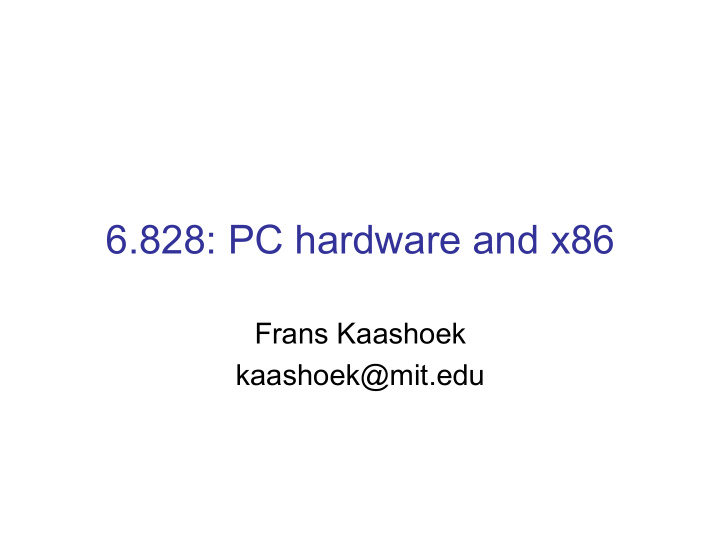



6.828: PC hardware and x86 Frans Kaashoek kaashoek@mit.edu
A PC how to make it to do something useful?
Outline • PC architecture • x86 instruction set Illustrate a few • gcc calling big CS ideas conventions • PC emulation
PC board
Abstract model Central Main Processing Memory Input/Output Unit • I/O: communicating data to and from devices • CPU: digital logic for performing computation • Memory: N words of B bits
The stored program computer Main memory instruction CPU instruction for (;;) { instruction next instruction } data data data • Memory holds instructions and data • CPU interpreter of instructions
x86 implementation 2 32 -1 instruction instruction instruction data data data 0 • EIP is incremented after each instruction • Instructions are different length • EIP modified by CALL, RET, JMP, and conditional JMP
Registers for work space • 8, 16, and 32 bit versions • By convention some registers for special purposes • Example: ADD EAX, 10 • Other instructions: SUB, AND, etc.
EFLAGS register • Test instructions: TEST EAX, 0 • Conditional JMP instructions: JNZ address
Memory: more work space • Memory instructions: MOV, PUSH, POP, etc • Most instructions can take a memory address
Stack memory + operations • Stack grows down • Use to implement procedure calls
More memory • 8086 16 registers and 20-bit bus addresses • The extra 4 bits come segment registers – CS: code segment, for EIP – SS: stack segment, for SP and BP – DS: data segment for load/store via other registers – ES: another data segment, destination for string ops – For example: CS=4096 to start executing at 65536 • Makes life more complicated – Cannot use 16 bit address of stack variable as pointer – Pointer arithmetic and array indexing across segment boundaries – For a far pointer programmer must include segment reg
And more memory • 80386: 32 bit data and bus addresses • Now: the transition to 64 bit addresses • Backwards compatibility: – Boots in 16-bit mode, and boot.S switches to protected mode with 32-bit addresses – Prefix 0x66 gets you 32-bit: • MOVW = 0x66 MOVW – .code32 in boot.S tells assembler to insert 0x66 • 80386 also added virtual memory addresses – Segment registers are indices into a table – Page table hardware
I/O space and instructions • 8086: Only 1024 I/O addresses
Memory-mapped I/O • Use normal addresses – No need for special instructions – No 1024 limit – System controller routes to device • Works like “ magic ” memory – Addressed and accessed like memory – But does not behave like memory – Reads and writes have “ side effects ” – Read result can change due to external events
Physical memory layout
x86 instruction set • Instructions classes: – Data movement: MOV, PUSH, POP, … – Arithmetic: TEST, SHL, ADD, … – I/O: IN, OUT, … – Control: JMP, JZ, JNZ, CALL, RET – String: REP, MOVSB, … – System: IRET, INT, … • Intel architecture manual Volume 2 – Intel syntax: op dst, src – AT&T (gcc/gas) syntax: op src, dst
Gcc calling conventions for JOS Prologue : pushl %ebp movl %esp, %ebp Epilogue : movl %ebp, %esp popl %ebp • Saved %ebp ’ s form a chain, can walk stack • Arguments and locals at fixed offsets from EBP
gcc procedure calling conventions Caller saved – %eax contains return value, %ecx, %edx may be trashed – %ebp, %ebx, %esi, %edi must be as before call Callee saved – Note that %ebp isn’t strictly necessary, but we compile JOS and xv6 this way for convenience of walking up the stack.
Example
From C to running program gcc gas .o .c .asm loader memory a.out ld gcc gas .o .c .asm • Compiler, assembler, linker, and loader
Development using PC emulator • QEMU PC emulator – does what a real PC does JOS – Only implemented in PC emulator software! • Runs like a normal Linux program on “ host ” PC operating system
Emulation of memory
Emulation of CPU
Emulation x86 memory
Emulating devices • Hard disk: using a file of the host • VGA display: draw in a host window • Keyboard: hosts ’ s keyboard API • Clock chip: host ’ s clock • Etc.
Summary • For lab: PC and x86 • Illustrate several big ideas: – Stored program computer – Stack – Memory-mapped I/O – Software = hardware
Recommend
More recommend